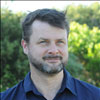
Machine Learning and Robotics in Architecture
The collaboration between architecture (CIBER) and the Newcastle Robotics Laboratory is one of the largest of its kind in Australia. In the past ten years the two chief investigators Professor Michael Ostwald and Associate Professor Stephan Chalup obtained funding from more than four grants including two past ARC discovery grants.
In combination, this unique interdisciplinary collaborative partnership has resulted in over 40 joint publications, several industry reports, multiple jointly supervised postgraduate completions and the development of software prototypes. This interdisciplinary work has been extremely inspiring for the researchers and students involved.
While machine learning based data analysis introduced a new level of precision into architectural and urban research, architectural intuition about space perception and aesthetics has proven to be a fruitful source of inspiration for artificial intelligence research in robotics. Future projects are aiming at transforming the developed technology into industrial applications, for example, in the health and associated building sector.

Major Grants
Prof. M. J. Ostwald snd AProf. S. Chalup. DP1092679. Modelling and Predicting patterns of pedestrian movement: using robotics and machine learning to improve the design of urban space. $486,000.
Prof. M. J. Ostwald snd AProf. S. Chalup. DP0770106. Shaping social and cultural spaces: the application of computer visualisation and machine learning techniques to the design of architectural and urban spaces. $275,829.
- Bhatia, Shashank, Stephan K. Chalup, Michael J. Ostwald (2013) 'Improving Wayfinding: A method for the empirical evaluation of structural saliency using 3D Isovists' Architectural Science Review. 56(3) 220-231.
- Wong, Aaron S. W. Stephan K. Chalup, Shashank Bhatia, Arash Jalalian, Jason Kulk, Steven Nicklin, and Michael J. Ostwald. (2012) Visual gaze analysis of robotic pedestrians moving in urban space. Architectural Science Review, 55(3):213-223.
- Jalalian, Arash, Stephan K. Chalup, and Michael J. Ostwald. (2011) Architectural evaluation of simulated pedestrian spatial behaviour. Architectural Science Review54(2), pp. 132–140.
- Ostwald, Michael J. Josephine Vaughan and Stephan K. Chalup. (2011) Data flow and processing in the computational fractal analysis method. CAADRIA 2011. Circuit Bending, Breaking and Mending. The 16th International Conference of the Association for Computer-Aided Architectural Design Research in Asia.
- Chalup, Stephan K. and Michael J. Ostwald. (2010) Anthropocentric Biocybernetic Approaches to Architectural Analysis: New Methods for Investigating the Built Environment. In: Paul S. Geller (ed.). Built Environment: Design Management and Applications. pp. 121–145, Nova Scientific: ISBN: 978-1-60876-915-5.
- Chalup, Stephan K. Kenny Hong, and Michael J. Ostwald. (2010) Simulating Pareidolia of Faces for Architectural Image Analysis. International Journal of Computer Information Systems and Industrial Management Applications (IJCISIM) 2, pp. 262–278.
- Chalup, Stephan K. Naomi Henderson, Michael J. Ostwald and Lukasz Wiklendt. (2009) A Computational Approach to Fractal Analysis of a Cityscape's Skyline. Architectural Science Review 52(2), pp. 126–134, ISSN 0003-8628
- Ostwald, Michael J. Josephine Vaughan and Stephan K. Chalup. (2009) A Computational Investigation into the Fractal Dimensions of the Architecture of Kazuyo Sejima. Design Principles and Practices: An International Journal 3(1), pp. 231–244, ISSN: 1833-1874
- Ostwald, Michael J. Christopher C. Tucker, and Stephan K. Chalup. (2009) Line segmentation: A computational technique for architectural image analysis, ACADIA 09: reForm: Building a Better Tomorrow: Proceedings of the 29th Annual Conference of the Association for Computer Aided Design in Architecture (ACADIA),Chicago, IL.
- Stephan K. Chalup, Kenny Hong, and Michael J. Ostwald. (2008) A Face-House Paradigm for Architectural Scene Analysis. In: Richard Chbeir, Youakim Badr, Ajith Abraham, Dominique Laurent, Fernnando Ferri (eds.). CSTST 2008: Proceedings of The Fifth International Conference on Soft Computing as Transdisciplinary Science and Technology, pp. 397–403, ACM ISBN 978-1-60558-046-3.
- Michael J. Ostwald, Josephine Vaughan and Stephan K. Chalup. (2008) A computational analysis of fractal dimensions in the architecture of Eileen Gray. In: Andrew Kudless, Neri Oxman and Marc Swackhamer (eds.). ACADIA 2008: Silicon + Skin: Biological Processes and Computation. Proceedings of the 28th Annual Conference of the Association for Computer Aided Design in Architecture, pp. 256–263, ISBN 978-0-9789463-2-6.
- Stephan K. Chalup, Riley Clement, Chris Tucker and Michael J. Ostwald. (2007) Modelling Architectural Visual Experience Using Non-linear Dimensionality Reduction. In: M. Randall, H. Abbass, and J. Wiles (eds.). Australian Conference on Artificial Life (ACAL 2007), Lecture Notes in Computer Science LNCS 4828, pp. 84–95.
- Stephan K. Chalup, Riley Clement, Joshua Marshall, Chris Tucker, and Michael J. Ostwald. (2007) Representations of Streetscape Perceptions Through Manifold Learning in the Space of Hough Arrays. Proceedings of the 2007 IEEE Symposium on Artificial Life (CI-ALife 2007), April 1-5, 2007, pp. 362–369, ISBN: 1-4244-0701-X, IEEE.
- Chris Tucker, Michael J. Ostwald, Stephan K. Chalup and Josh Marshall. (2005) A Method for Visual Analysis of the Streetscape. In: Akkelies van Nes (ed.). 5th International Space Syntax Symposium Delft, 13-17 June 2005, Proceedings, Volume 2, Delft, The Netherlands: 519-529
- Tucker, Chris., Michael J. Ostwald and Stephan K. Chalup. (2004) A Method for the Visual Analysis of Streetscape Character Using Digital Image Processing. In: Zbigniew Bromberek (Ed.). Contexts of Architecture: Proceedings of the 38th Annual Conference of the Architectural Science Association ANZAScA and the International Building Performance Simulation Association. (Launceston, Tasmania: Australia and New Zealand Architectural Science Association, 2004), pp. 134-140
The University of Newcastle acknowledges the traditional custodians of the lands within our footprint areas: Awabakal, Darkinjung, Biripai, Worimi, Wonnarua, and Eora Nations. We also pay respect to the wisdom of our Elders past and present.
